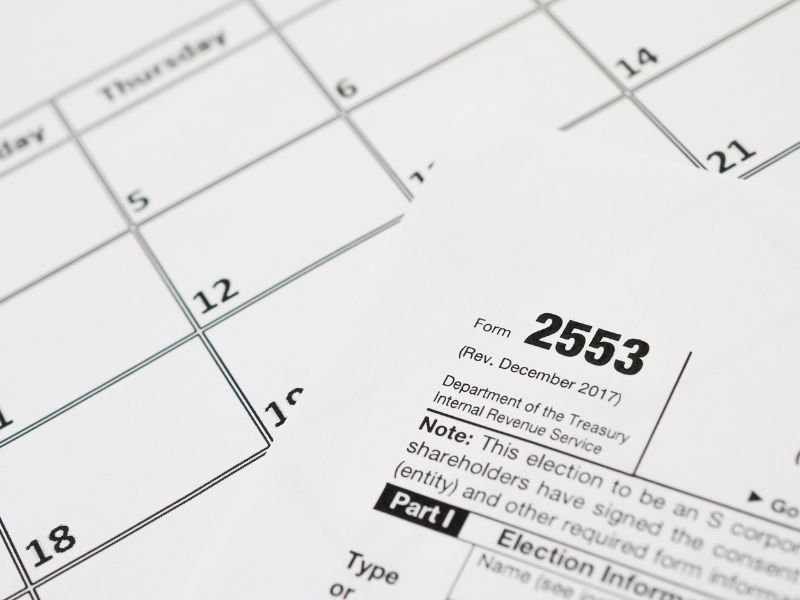Paying taxes and figuring out how much you owe in taxes is often one of the most complicated parts of starting a small business. The one good thing is that you don’t have to have all the answers before you get started.
Here’s what you need to know to make an S corporation election, including who benefits from an S corporation election and how to fill out Form 2553.
What is an S corporation?

An S corporation or small business corporation is a way of registering your business that’s suitable for small businesses but tends to be best for businesses a little larger than your typical limited liability company (LLC) or sole proprietorship.
The main advantage of having an S corporation instead of a different form of incorporation is that it means that your business’s income is only taxed once. Under a C corporation, the other form of incorporation, business income is taxed twice, once when the business files its taxes and then again when shareholders pay on taxable income.
S corporations only pay once, but they aren’t suitable for all businesses.
S corporation or C corporation: Which is right for my business?
Knowing whether a business can qualify as an S corporation is often the most important part of determining which filing status makes the most sense. Not all small businesses can make an S corporation election, and misfiling can lead to delays, fines, and other problems.
Here are some of the key requirements for making an S corporation election:
- The business is 100% domestic.
- All shareholders are U.S. citizens or residents.
- There are 100 or fewer total shareholders (excluding multiple members of a single family, who can be counted as a single shareholder).
- The business has only one class of stocks.
- Shareholders must be individuals, estates, certain trusts, or an exempt organization.
These are just the basics, and some other exemptions might preclude a business from being a candidate for an S corporation election.
Another good way to tell whether a business can file an S corporation election is if that business makes $250,000 per year or less in corporate profits per owner. Businesses that make more than that likely need to be C corporations and may even benefit from filing that way.
Advantages of having an S corporation
The biggest advantage of an S corporation is that the tax on corporate profits isn’t taxed at the corporate level. Instead, taxes are paid on corporate profits earned by the shareholders and owners.
You can also split profits between shareholder profits, which are taxed, and distributive share, which isn’t subject to employment taxes.
Money is important here too because if shareholder income exceeds $250,000, it may not make financial sense to file this way since shareholders could be taxed more than would need to be paid in corporate taxes otherwise. Essentially, making an S corporation election allows you to determine how the tax burden will be shared.
What is IRS Form 2553?

IRS Form 2553 is how a corporation or LLC can make an S corporation election. You need to correctly file IRS Form 2553 with the IRS within the first 75 days of the business’s tax year.
So you have a month and a half from the start of the tax year to correctly file this form. Filing early is a good idea both because the paperwork is likely to be processed faster and because filing early gives you more time to fix any mistakes if necessary.
It typically takes 2–3 months for the IRS to process Form 2553, though, so don’t panic if you don’t hear back right away after filing. Chances are everything is fine.
If you previously filed as a C corporation but want to file as an S corporation the following year, you can also make an S corporation election the prior tax year, starting January 1. However, most businesses file their S corporation election in the same tax year. (Remember, the small business tax year starts on November 8, so Form 2553 is due on January 22 for most businesses.)
How to fill out IRS Form 2553
Filling out IRS Form 2553 isn’t complicated, but you do need to make sure you fill it out completely and provide all the correct information. Here’s how:
Business information
The first thing you need is the business’s official name as stated in the corporate charter or other legal documents used to create the corporation. You also need the employer identification number and the effective date of the election (generally November 8).
If you are making an S corporation election for the first time, you may also need the dates the corporation first had shareholders (the owners) and assets or first started doing business instead of the start of the tax year.
In Item F, on Form 2553, you will select the relevant year.
Required Signatures
Form 2553 must be signed and dated by:
- The president
- Vice president
- Treasurer
- Assistant treasurer
- Chief accounting officer
- OR any other authorized corporate officer
Without a proper signature and date, the form is invalid.
Shareholder consent
Shareholders may be required to consent to the S corporation election. Shareholders who own stock on the day the election is made must consent, and you must include the consent statement in column K of Form 2553. List the number of shares each stockholder owns in Column L and the Social Security number of each stockholder in Column J.
Lastly, Column N contains the month and day of each shareholder‘s tax year.
Part 2: Corporation fees
There are three ways to file, each with its fees. Read Section 444 to see which applies to your business.
Part 3: Owner consent and filing
If you are eligible for a qualified subchapter S trust, this section must be filled out by a legal beneficiary.
Part 4: Late filing
Part 4 allows you to fill out the form or make amendments to an existing S corporation filing if you need to make late elections.
The whole process should take 16 hours of active time or less. It’s really that simple!
Wrap-up
There are many reasons why your business might benefit from declaring itself an S corporation instead of an LLC, sole proprietorship, or C corporation. While avoiding double taxation is usually the main reason, it can also help streamline your business and save you time with accounting and finances, so you can use it for other tasks.
Remember that you and any other owners or profit-sharing partners need to be on board to make the switch and that you have limited time to file as an S corporation each year. From there, you should be good to go.

